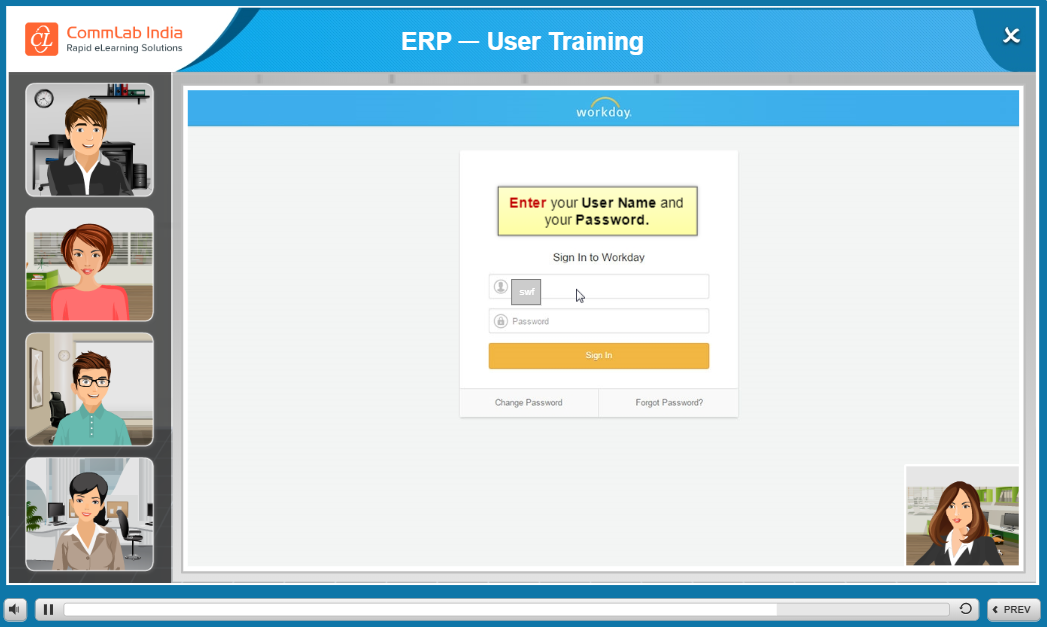From Off Hand to Hands-On: 4 Situations Simulations Make Sense in eLearning

It is the performance of employees that matters and makes a difference to an organization. Hence, organizations are on a constant run to improve employee performance by imparting training using various instructional strategies. But not every instructional strategy can help improve the skills of your employees. For example, a mere classroom session explaining how to perform a certain task will not lead to learners mastering that skill. Even a video-based eLearning will not do. But using simulations in eLearning definitely will!
What are Simulations in eLearning?
Simulations in eLearning mimic the environment and conditions of real-life to allow learners to explore, learn, and practice, thus preparing them for on-the-job tasks they are likely to encounter.
When should you use simulations in eLearning?
- When employees need to master skill-based tasks
- When the process is extremely complicated
- When there is zero tolerance for error
- To offer an active learning experience
What are Simulations in eLearning?
Simulations in eLearning mimic the environment and conditions of real-life to allow learners explore, learn, and practice, thus preparing them for on-the-job tasks they are likely to encounter. They provide learners a risk-free platform to practice and lead to a reduction in the overall training time and cost, not to mention the costly repercussions associated with tasks that go haywire.

eLearning simulations can be developed in three modes or a combination of these modes:
Watch Simulation – In a ‘Watch’ simulation, employees are shown how to perform a particular action within a software, step-by-step.
Try Simulation – In a ‘Try’ simulation, learners will be asked to try executing the task with hints being provided as and when necessary.
Do Simulation – In a ‘Do’ simulation, learners will be asked to do the task without any assistance.
However, no matter how beneficial simulation-based eLearning courses are, it pays to understand when they can be best leveraged, to ensure your efforts are in the being channelized in the right direction.
So, When Should You Use Simulations in eLearning?
When Employees Must Master Skill-Based Tasks
How do you usually train your employees on skill-based tasks? You might conduct a classroom session explaining the task, face-to-face demos, or maybe arrange for on-the-job observation. But don’t you think all these methods are extremely time-consuming and also costly?
What could be a better way to provide practice and facilitate quick skill development than eLearning simulations? For example, let’s say you introduced a new ERP software in your organization, and want your employees to learn how to perform the various tasks/operations/functions within it.
You can deliver a simulation-based eLearning course which will replicate the ERP software, thus allowing learners to explore every single task in the tool before using it on the job. They can also practice and become efficient in a short span of time compared to the traditional methods of learning.
To make it more effective, each of the tasks can be developed as individual modules. As each employee might have to deal with different tasks within the system, separating the tasks into individual modules will make it easier for learners to choose a module based on their requirement. Also, these courses can be made responsive, allowing learners to take them even on their mobiles, at the precise moment of need.
When the Process is Extremely Complicated/Risky
While some processes are easy, some are complicated. While some processes are safe to perform, some are extremely risky. For example, a surgical process or an experiment involving hazardous chemicals. While the former is too complicated to understand or learn in a single face-to-face session, the latter is too risky – both have great potential for real-time errors which might be extremely costly.
A complicated process like a surgical process consists of several subtasks which learners need to be adept at doing. When training is delivered through simulations in eLearning, learners are being provided a simulated environment of the actual process, allowing them to test and hone all their skills in the simulated environment, without the fear of failure. As they practice, their skill gets stronger and confidence builds up, preparing them completely for the real world and increasing their ability to transfer the acquired knowledge and skill into the workplace.
With eLearning simulations, the fear of failure or fear of incorrect handling can be completely eradicated. For instance, for the second example, a simulation replicating the lab can be created. Learners can be asked to choose the equipment and chemicals necessary to perform the experiment. Then they can be asked to do the experiment step by step. No matter how dangerous dealing with chemicals is, dealing with them within an online simulation will provide learners the power to learn the right and wrong way of handling such risky processes, without putting themselves through any danger.
When There is Zero Tolerance for Error
Some tasks can’t afford even a single error. Even one minute error can lead to a huge loss or grave danger. Consider a new doctor about to perform a complicated brain surgery or a blue-collared worker new to a hazardous area. These are situations where organizations wouldn’t want employees to experiment and learn on the job.
How can you ensure your learners gather enough skills to perform the job without a single error? Through practice rather than mere reading or watching videos on how to do it. Since eLearning simulations are all about providing a safe platform to practice, once a course on such tasks is developed and delivered to your learners, they will be able to practice efficiently until they are able to handle the stress and are clear of how to do it. They learn by trial-and-error and gain adequate experience to develop the necessary skill.
When You Want to Provide an Active Learning Experience
One of the main reasons learners do not engage in learning is due to dull, unengaging content. A passive learning experience will eventually lead to minimal knowledge acquisition. And the whole purpose of training is lost – to increase learners’ productivity.
But with simulations in eLearning, it’s time to bid farewell to a dull, dreary eLearning experience. By delivering training through eLearning simulations, you are allowing learners to get immersed in a simulated environment close to their actual work environment. They can immerse themselves in situations and challenges they are likely to face at their workplace in the future – have a conversation with a customer, handle equipment, operate a machine, or interact with a software.
Thus, an overall active learning experience is provided to them, ensuring they stay engaged throughout the course, while simultaneously grasping the important details necessary to perform the job perfectly.
Your learners can take maximum advantage of simulation-based eLearning courses if and only if they can access them as and when a need arises, and not just confined to a certain time or space. This can be done by developing each simulation as a microlearning asset (a video or an infographic to name a few). Yes, implementing microlearning will give you a lot to flexibility to offer not just simulations but even scenarios, quizzes, and games in small doses to engage learners, beat the forgetting curve, and improve productivity. Get more insights on microlearning in this free guide.




![Tips to Boost Health & Safety Training with Simulations [Infographic]](https://blog.commlabindia.com/hubfs/blogs/simulations-in-health-and-safety-training-tips.jpg)
